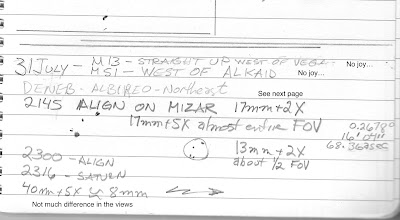On an astronomy forum I was chatting with another old guy about star-hopping, locating objects such as nebulas by knowing the constellations and moving from point to point. He said, “I agree, Mike, but you know what? At my age I want to spend my time looking at things, not looking for them.” That was a couple of months ago. Yesterday, I bought a Celestron AVX German Equatorial Mount and a power pack. I already was not a fan of Celestron's engineering, but I was also already a fan of their customer support: they make things right, or did by me.
My first adult telescope was a Celestron EQ-130 Newtonian reflector, (130mm = 5 inches) with German equatorial mount. My wife and daughter bought it for me. I selected the make and model that was closest to the Criterion 4-inch reflector that I grew up with. But they don’t make ‘em like they used to. The control rods (“cables”) were not positioned well: the tube was always in the way. The setting circles were mere adornment. No screw was a thread longer than it needed to be. As a result of the screws lost to the grass in the backyard, I became a fan of the fasteners aisle at Home Depot. Now I have a little plastic bag with many measures of 5-mm and 7-mm hex head screws. It comes in handy, even though I donated the telescope to the Goodwill this past spring. (On the positive side, the red-dot finder failed. The rocker switch spring snapped inside. I emailed Celestron to find out about buying a replacement viewer and two showed up in the mail, one of each type for the telescope, without an invoice.)
Anyway, here and now, availability was also an issue. Eighteen months into Covid-19 and the supplies are just not in stock. I shopped online for a couple of weeks across eight or ten retailers looking for comparable and competitive alternatives.
The deciding factor here was the release of Explore Scientific's new EXOS-2 PMC Eight goto mount at the same price: $999. The new version requires an external device for a controller:
Explore Scientific's PMC-Eight GOTO system can be controlled wirelessly or wired with a tablet or PC, with Windows 8.1 or 10, Android, Amazon Fire, or iOS, with a free app called ExploreStars. Tablet must be purchased separately.
I am a fan of Explore Scientific. In addition a telescope and two mounts (tripods), I have a 5X focal extender, and other accessories. I was pre-sold on two occasions. When first I called them, the customer service representative listened to what I wanted, put me on hold, went into the warehouse, and came back with an alternative. It was Mom-and-Pop customer service. The second event was their CEO, Scott Roberts, speaking to our local astronomy club. Scott supports amateur astronomy with his own time. Explore Scientific sponsors “global star parties” both live (pre-Covid) and on YouTube. Scott Roberts is on the board of Astronomers Without Borders.
That being as it may, I do not own a tablet or laptop that is compatible with the Explore Scientific EXOS-2 PMC Eight. So, that would be another expense. And the phone or pad introduces another source of light, dim it as you can. And I already do not use my iPhone with my telescope because it is a pain in the neck in the dark: touch the wrong thing, you get the wrong result. I have used the hand paddle type control before when I borrowed a computerized telescope from my local club. It was not the best interface, but it is a mode that I can live with. In fact, I sent a hardcopy letter in the mail (three pages with attachments, and my business card) to Explore Scientific asking them to hold for me the next used EXOS-2 previous version with paddle control that comes in. That was on August 18. I never received any acknowledgement of the letter. So, I moved on.
 |
| I googled "Celestron AVX Problems" and followed the links. |
The Celestron Advanced VX mount is sold as being capable of 30 lbs (13.5 kg). The saleslady at Woodland Hills Camera and Telescope (Telescopes.net) said that my 22-lb Bresser 8-inch Newtonian would be at the practical limit without an eyepiece or finder. However, my grab-and-go is an Explore Scientific 102mm refractor which weighs 13 lbs. Also, still in the carrying case, I have an Astronomics AT 115 ED (extremely low dispersion glass) APO (apochromatic triplet lens) at 17 lbs. So, both of those will work with this.
Also a positive consideration was that I know from my (limited) previous experience with a computerized "go-to" mount that it is not as easy or as much fun as one would like to believe. So, I bought this as much as a learning tool, something new to do under the stars.
PREVIOUSLY ON NECESSARY FACTS
Observing with NASA: An Open Platform for Citizen Science
New Telescope: Explore First Light 102 Refractor
$2500 Viewed Through a Telescope
Testing the Stellarvue Correcting Diagonal Prism




